fuel filter SKODA YETI 2009 1.G / 5L Owner's Manual
[x] Cancel search | Manufacturer: SKODA, Model Year: 2009, Model line: YETI, Model: SKODA YETI 2009 1.G / 5LPages: 271, PDF Size: 16.24 MB
Page 5 of 271
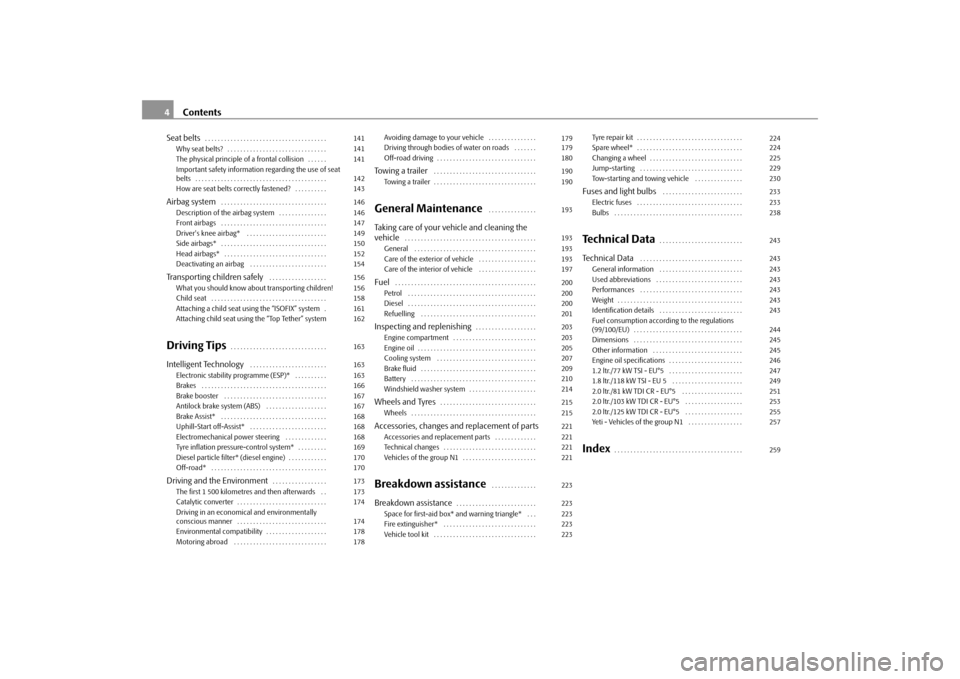
Contents 4
Seat belts
. . . . . . . . . . . . . . . . . . . . . . . . . . . . . . . . . . . . . .
Why seat belts? . . . . . . . . . . . . . . . . . . . . . . . . . . . . . . .
The physical principle of a frontal collision . . . . . .
Important safety information regarding the use of seat
belts . . . . . . . . . . . . . . . . . . . . . . . . . . . . . . . . . . . . . . . . .
How are seat belts correctly fastened? . . . . . . . . . .
Airbag system
. . . . . . . . . . . . . . . . . . . . . . . . . . . . . . . . .
Description of the airbag system . . . . . . . . . . . . . . .
Front airbags . . . . . . . . . . . . . . . . . . . . . . . . . . . . . . . . .
Driver's knee airbag* . . . . . . . . . . . . . . . . . . . . . . . . .
Side airbags* . . . . . . . . . . . . . . . . . . . . . . . . . . . . . . . . .
Head airbags* . . . . . . . . . . . . . . . . . . . . . . . . . . . . . . . .
Deactivating an airbag . . . . . . . . . . . . . . . . . . . . . . . .
Transporting children safely
. . . . . . . . . . . . . . . . . .
What you should know about transporting children!
Child seat . . . . . . . . . . . . . . . . . . . . . . . . . . . . . . . . . . . .
Attaching a child seat using the “ISOFIX” system .
Attaching child seat using the “Top Tether” system
Driving Tips
. . . . . . . . . . . . . . . . . . . . . . . . . . . . . .
Intelligent Technology
. . . . . . . . . . . . . . . . . . . . . . . .
Electronic stability programme (ESP)* . . . . . . . . . .
Brakes . . . . . . . . . . . . . . . . . . . . . . . . . . . . . . . . . . . . . . .
Brake booster . . . . . . . . . . . . . . . . . . . . . . . . . . . . . . . .
Antilock brake system (ABS) . . . . . . . . . . . . . . . . . . .
Brake Assist* . . . . . . . . . . . . . . . . . . . . . . . . . . . . . . . . .
Uphill-Start off-Assist* . . . . . . . . . . . . . . . . . . . . . . . .
Electromechanical power steering . . . . . . . . . . . . .
Tyre inflation pressure-control system* . . . . . . . . .
Diesel particle filter* (diesel engine) . . . . . . . . . . . .
Off-road* . . . . . . . . . . . . . . . . . . . . . . . . . . . . . . . . . . . .
Driving and the Environment
. . . . . . . . . . . . . . . . .
The first 1 500 kilometres and then afterwards . .
Catalytic converter . . . . . . . . . . . . . . . . . . . . . . . . . . . .
Driving in an economical and environmentally
conscious manner . . . . . . . . . . . . . . . . . . . . . . . . . . . .
Environmental compatibility . . . . . . . . . . . . . . . . . . .
Motoring abroad . . . . . . . . . . . . . . . . . . . . . . . . . . . . . Avoiding damage to your vehicle . . . . . . . . . . . . . . .
Driving through bodies of water on roads . . . . . . .
Off-road driving . . . . . . . . . . . . . . . . . . . . . . . . . . . . . . .
To w i n g a t r a i l e r
. . . . . . . . . . . . . . . . . . . . . . . . . . . . . . . .
Towing a trailer . . . . . . . . . . . . . . . . . . . . . . . . . . . . . . . .
General Maintenance
. . . . . . . . . . . . . . .
Taking care of your vehicle and cleaning the
vehicle
. . . . . . . . . . . . . . . . . . . . . . . . . . . . . . . . . . . . . . . . .
General . . . . . . . . . . . . . . . . . . . . . . . . . . . . . . . . . . . . . .
Care of the exterior of vehicle . . . . . . . . . . . . . . . . . .
Care of the interior of vehicle . . . . . . . . . . . . . . . . . .
Fuel
. . . . . . . . . . . . . . . . . . . . . . . . . . . . . . . . . . . . . . . . . . . .
Petrol . . . . . . . . . . . . . . . . . . . . . . . . . . . . . . . . . . . . . . . .
Diesel . . . . . . . . . . . . . . . . . . . . . . . . . . . . . . . . . . . . . . . .
Refuelling . . . . . . . . . . . . . . . . . . . . . . . . . . . . . . . . . . . .
Inspecting and replenishing
. . . . . . . . . . . . . . . . . . .
Engine compartment . . . . . . . . . . . . . . . . . . . . . . . . . .
Engine oil . . . . . . . . . . . . . . . . . . . . . . . . . . . . . . . . . . . . .
Cooling system . . . . . . . . . . . . . . . . . . . . . . . . . . . . . . .
Brake fluid . . . . . . . . . . . . . . . . . . . . . . . . . . . . . . . . . . . .
Battery . . . . . . . . . . . . . . . . . . . . . . . . . . . . . . . . . . . . . . .
Windshield washer system . . . . . . . . . . . . . . . . . . . . .
Wheels and Tyres
. . . . . . . . . . . . . . . . . . . . . . . . . . . . . .
Wheels . . . . . . . . . . . . . . . . . . . . . . . . . . . . . . . . . . . . . . .
Accessories, changes and replacement of partsAccessories and replacement parts . . . . . . . . . . . . .
Technical changes . . . . . . . . . . . . . . . . . . . . . . . . . . . . .
Vehicles of the group N1 . . . . . . . . . . . . . . . . . . . . . . .Breakdown assistance
. . . . . . . . . . . . . .
Breakdown assistance
. . . . . . . . . . . . . . . . . . . . . . . . .
Space for first-aid box* and warning triangle* . . .
Fire extinguisher* . . . . . . . . . . . . . . . . . . . . . . . . . . . . .
Vehicle tool kit . . . . . . . . . . . . . . . . . . . . . . . . . . . . . . . .Tyre repair kit . . . . . . . . . . . . . . . . . . . . . . . . . . . . . . . . .
Spare wheel* . . . . . . . . . . . . . . . . . . . . . . . . . . . . . . . . .
Changing a wheel . . . . . . . . . . . . . . . . . . . . . . . . . . . . .
Jump-starting . . . . . . . . . . . . . . . . . . . . . . . . . . . . . . . .
Tow-starting and towing vehicle . . . . . . . . . . . . . . .
Fuses and light bulbs
. . . . . . . . . . . . . . . . . . . . . . . . .
Electric fuses . . . . . . . . . . . . . . . . . . . . . . . . . . . . . . . . .
Bulbs . . . . . . . . . . . . . . . . . . . . . . . . . . . . . . . . . . . . . . . .
Technical Data
. . . . . . . . . . . . . . . . . . . . . . . . . .
Technical Data
. . . . . . . . . . . . . . . . . . . . . . . . . . . . . . . .
General information . . . . . . . . . . . . . . . . . . . . . . . . . .
Used abbreviations . . . . . . . . . . . . . . . . . . . . . . . . . . .
Performances . . . . . . . . . . . . . . . . . . . . . . . . . . . . . . . .
Weight . . . . . . . . . . . . . . . . . . . . . . . . . . . . . . . . . . . . . . .
Identification details . . . . . . . . . . . . . . . . . . . . . . . . . .
Fuel consumption according to the regulations
(99/100/EU) . . . . . . . . . . . . . . . . . . . . . . . . . . . . . . . . . .
Dimensions . . . . . . . . . . . . . . . . . . . . . . . . . . . . . . . . . .
Other information . . . . . . . . . . . . . . . . . . . . . . . . . . . .
Engine oil specifications . . . . . . . . . . . . . . . . . . . . . . .
1.2 ltr./77 kW TSI - EU°5 . . . . . . . . . . . . . . . . . . . . . . .
1.8 ltr./118 kW TSI - EU 5 . . . . . . . . . . . . . . . . . . . . . .
2.0 ltr./81 kW TDI CR - EU°5 . . . . . . . . . . . . . . . . . . .
2.0 ltr./103 kW TDI CR - EU°5 . . . . . . . . . . . . . . . . . .
2.0 ltr./125 kW TDI CR - EU°5 . . . . . . . . . . . . . . . . . .
Yeti - Vehicles of the group N1 . . . . . . . . . . . . . . . . .
Index
. . . . . . . . . . . . . . . . . . . . . . . . . . . . . . . . . . . . . . . . 141
141
141
142
143
146
146
147
149
150
152
154
156
156
158
161
162
163
163
163
166
167
167
168
168
168
169
170
170
173
173
174
174
178
178179
179
180
190
190
193
193
193
193
197
200
200
200
201
203
203
205
207
209
210
214
215
215
221
221
221
221
223
223
223
223
223224
224
225
229
230
233
233
238
243
243
243
243
243
243
243
244
245
245
246
247
249
251
253
255
257
259
sgg.6.book Page 4 Thursday, September 24, 2009 2:32 PM
Page 31 of 271
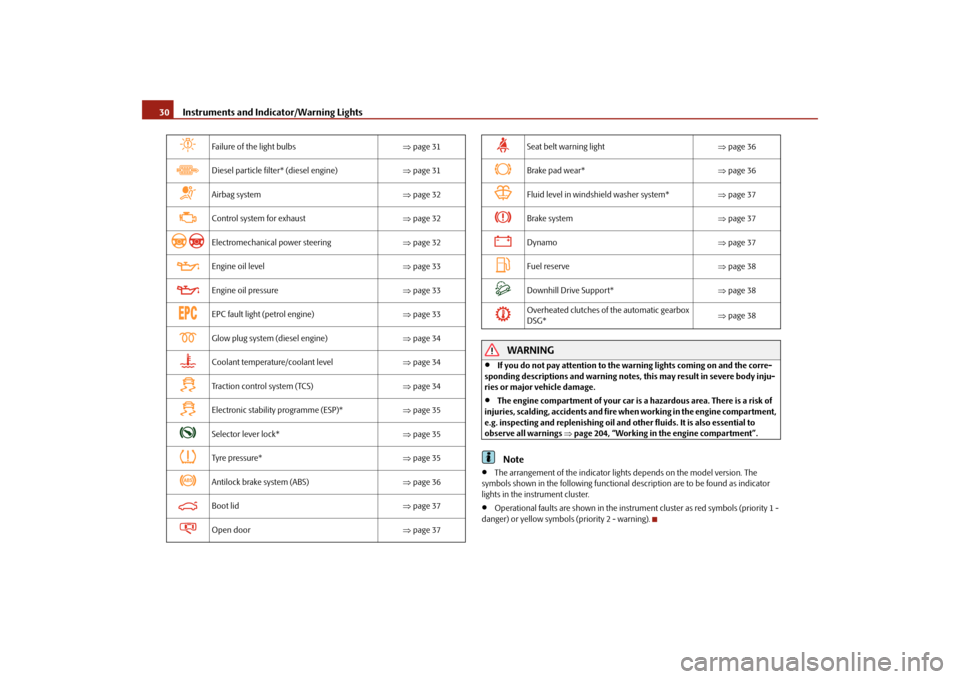
Instruments and Indicator/Warning Lights
30
WARNING
•
If you do not pay attention to the warning lights coming on and the corre-
sponding descriptions and warning notes, this may result in severe body inju- ries or major vehicle damage.•
The engine compartment of your car is
a hazardous area. There is a risk of
injuries, scalding, accidents and fire wh
en working in the engine compartment,
e.g. inspecting and replenishing oil and
other fluids. It is also essential to
observe all warnings
⇒page 204, “Working in the engine compartment”.
Note
•
The arrangement of the indicator lights depends on the model version. The
symbols shown in the following functional
description are to be
found as indicator
lights in the instrument cluster.•
Operational faults are shown in the instrument cluster as red symbols (priority 1 -
danger) or yellow symbol
s (priority 2 - warning).
Failure of the light bulbs
⇒page 31
Diesel particle filter* (diesel engine)
⇒page 31
Airbag system
⇒page 32
Control system for exhaust
⇒page 32
Electromechanical power steering
⇒page 32
Engine oil level
⇒page 33
Engine oil pressure
⇒page 33
EPC fault light (petrol engine)
⇒page 33
Glow plug system (diesel engine)
⇒page 34
Coolant temperature/coolant level
⇒page 34
Traction control system (TCS)
⇒page 34
Electronic stability programme (ESP)*
⇒page 35
Selector lever lock*
⇒page 35
Tyre pressure*
⇒page 35
Antilock brake system (ABS)
⇒page 36
Boot lid
⇒page 37
Open door
⇒page 37
Seat belt warning light
⇒page 36
Brake pad wear*
⇒page 36
Fluid level in windshield washer system*
⇒page 37
Brake system
⇒page 37
Dynamo
⇒page 37
Fuel reserve
⇒page 38
Downhill Drive Support*
⇒page 38
Overheated clutches of the automatic gearbox DSG*
⇒ page 38
sgg.6.book Page 30 Thursday, September 24, 2009 2:32 PM
Page 171 of 271

Intelligent Technology
170
Note
The tyre inflation pressure-control system:•
does not replace the regular tyre inflatio
n pressure control, because the system
cannot detect an even pressure loss;•
cannot warn in case of very rapid tyre inflation pressure loss, e.g. in case of sudden
tyre damage. In this case carefully bring the vehicle to a standstill without sudden steering movements and without sharp braking.•
In order to ensure a proper functioning
of the tyre inflation pressure-control
system, it is necessary to carry out the basic setting again every 10 000 km or 1x a year.Diesel particle filter* (diesel engine)In the diesel particle filter the resu
lting soot particles are collected and
burnt during the combustion of diesel fuel.Code
7GG
, 7MB
or 7MG
on the vehicle data sticker, see
⇒fig. 157
, indicates that your
vehicle is equipped
with a diesel particle filter. The ve
hicle data sticker is located on
the floor of the luggage compartment and is also stated in the Service schedule. The diesel particle filter filters the soot particles completely from the exhaust. The soot is collected in the diesel particle filter and
burnt regularly. To assist this procedure, we
recommend not to drive regu
larly over short distances.
If the diesel particle filter is clogged or there
is a fault, it is indicated by the warning light
.
WARNING
•
The diesel particle filter
achieves very high temp
eratures. Therefore do not
park at points where the hot filter comes into direct contact with dry grass or other combustible materials - risk of fire!•
Never use additional underbody protection or corrosion-protection agents
for the exhaust pipes, catalytic converters,
diesel particle filter
or heat shields.
When the engine reaches its operating
temperature, these
substances might
ignite - risk of fire.
Note
•
When using diesel fuel with high sulphur cont
ent the life of the diesel particle filter
is clearly reduced. A specialist garage will
be able to tell you which countries use only
diesel fuel with high sulphur content.Off-road*GeneralThe Off-road mode comprises functions which assist off-road driving. The following functions are integrated in the Off-road mode:•
Start-Off Assist
⇒page 171,
•
Downhill Drive Support
⇒page 171,
•
EDL Off-road
⇒page 164,
Fig. 157 Vehicle data sticker
Fig. 158 Off-road switch
sgg.6.book Page 170 Thursday, September 24, 2009 2:32 PM
Page 198 of 271
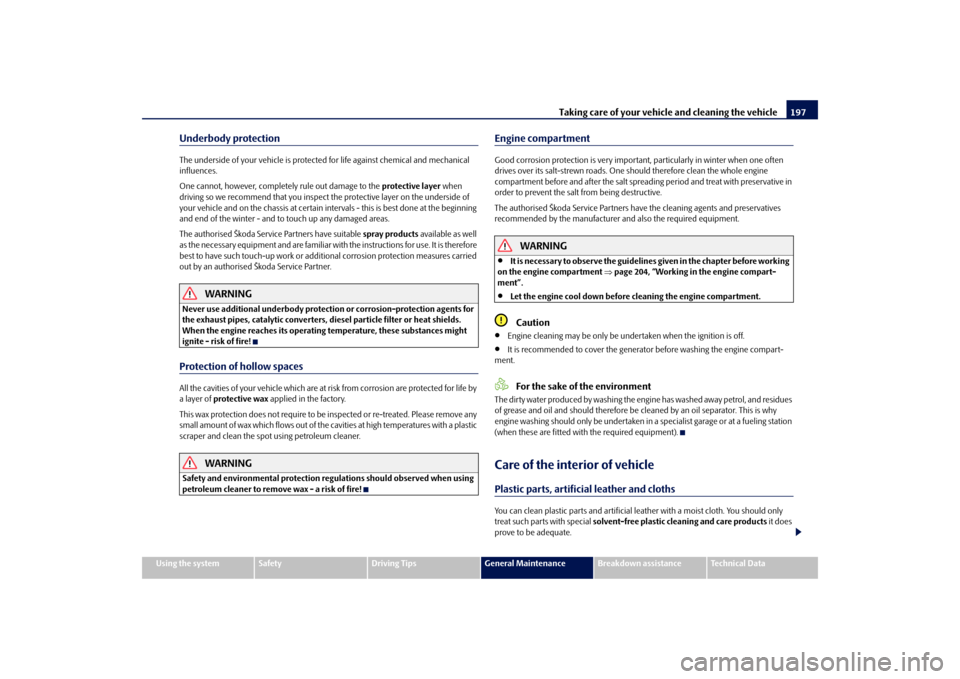
Taking care of your vehicle and cleaning the vehicle
197
Using the system
Safety
Driving Tips
General Maintenance
Breakdown assistance
Technical Data
Underbody protectionThe underside of your vehicle is protected for life against chemical and mechanical influences. One cannot, however, complete
ly rule out damage to the
protective layer
when
driving so we recommend that you inspect the protective layer on the underside of your vehicle and on the
chassis at certain intervals - this is best done at the beginning
and end of the winter - and to touch up any damaged areas. The authorised Škoda Service Partners have suitable
spray products
available as well
as the necessary equipment and are familiar with the instructions for use. It is therefore best to have such touch-up
work or additional corrosion
protection measures carried
out by an authorised Škoda Service Partner.
WARNING
Never use additional underbody protection or corrosion-protection agents for the exhaust pipes, catalytic converters, di
esel particle filter or heat shields.
When the engine reaches its operating
temperature, these substances might
ignite - risk of fire!Protection of hollow spacesAll the cavities of your vehicle which are at risk from corrosion are protected for life by a layer of
protective wax
applied in the factory.
This wax protection does not require to be inspected or re-treated. Please remove any small amount of wax which flows out of the cavities at high temperatures with a plastic scraper and clean the spot using petroleum cleaner.
WARNING
Safety and environmental pr
otection regulations should observed when using
petroleum cleaner to remove wax - a risk of fire!
Engine compartmentGood corrosion protection is very importan
t, particularly in winter when one often
drives over its salt-strewn roads. One should therefore clean the whole engine compartment before and after the salt spread
ing period and treat with preservative in
order to prevent the salt from being destructive. The authorised Škoda Service Partners have the cleaning agents and preservatives recommended by the manufacturer and also the required equipment.
WARNING
•
It is necessary to observ
e the guidelines given in the chapter before working
on the engine compartment
⇒page 204, “Working in the engine compart-
ment”.•
Let the engine cool down before cleaning the engine compartment.Caution
•
Engine cleaning may be only be un
dertaken when the ignition is off.
•
It is recommended to cover the generator before washing the engine compart-
ment.
For the sake of the environment
The dirty water produced by washing the engine has washed away petrol, and residues of grease and oil and should therefore be
cleaned by an oil separator. This is why
engine washing should only be undertaken in
a specialist garage or at a fueling station
(when these are fitted with the required equipment).Care of the interior of vehiclePlastic parts, artificial leather and clothsYou can clean plastic parts and artificial le
ather with a moist cloth. You should only
treat such parts with special
solvent-free plastic cleaning and care products
it does
prove to be adequate.
sgg.6.book Page 197 Thursday, September 24, 2009 2:32 PM
Page 201 of 271

Fuel
200
FuelPetrolGrades of petrolThere are various grades of petrol. Please read
⇒page 243, “Technical Data” in order
to know which grade of petrol your vehicle
requires. You will also find the same infor-
mation affixed to the inside of th
e fuel filler flap of your vehicle
⇒page 201, fig. 168
.
A distinction is made between unleaded and
leaded petrol. All Škoda vehicles with
petrol engines are equipped wi
th a catalytic converter and must therefore be only
driven with
unleaded petrol
. Unleaded petrol complies with the
standard EN 228
.
The individual grades of petr
ol are distinguished by their
octane number
(RON).
Please adopt the following procedure if the grade of petrol which you normally use is not be available in exceptional circumstances. Engines which need
unleaded premium petrol 95 RON
can also be run on unleaded
regular petrol 91 RON. This does, however,
result in a slight loss in performance.
If, in an emergency, the only fuel availa
ble is one which has a lower octane number
than that required by the engine then only drive at medium engine speeds and lower engine loadings. You can make unlimited use of fuel whic
h has a higher octane number than that
required by the engine. There will, however, be no advantages gained by this in terms of engine performance and fuel consumption! The handling, performance and life of your
engine are determined to a significant
extent by the quality of the fuel. Do not use any petrol additives.
Use fuel which
complies with the standard EN 228
.
You can find further information on refuelling
⇒page 201, “Refuelling”.
Caution
•
Filling the tank even only once with le
aded petrol will resu
lt in the catalytic
converter being destroyed.•
Operating the engine with petrol of a low octane number can result in engine
damage at high revolutions or severe engine loading.
DieselDiesel fuelYour vehicle can be operated with
diesel fuel
, which complies with the standard
EN 590
.
Fuel additives You must not use fuel additives, so-called “flow improvers” (petrol and similar prod- ucts) in diesel fuel. If the quality of the diesel fuel is poor, it is then necessary to drain the
fuel filter
more
often than stated in the Service schedule. You can find information on refuelling
⇒page 201, “Refuelling”.
Caution
•
Only use fuel which complies with the standard
EN 590
. Filling the tank even only
once, which does not comply with the stan
dard, can result in damage to the fuel
system.•
Water which has collected in the fuel filter can result in engine problems.
•
Your vehicle is not adapted for use of biodie
sel, therefore this fuel must not be refu-
elled and driven. Using this biodiesel can lead to damage to the engine or the fuel system.Operation in winterWinter-grade diesel fuel A different grade of diesel fuel is available at filling stations in winter than during the summer. Using “summer-grade diesel fuel” at temperatures below 0°C can result in operational problems because the diesel beco
mes viscous as a result of paraffin sepa-
ration.
sgg.6.book Page 200 Thursday, September 24, 2009 2:32 PM
Page 202 of 271

Fuel
201
Using the system
Safety
Driving Tips
General Maintenance
Breakdown assistance
Technical Data
It is therefore the case that EN 590 prescribes diesel fuel class for certain periods of the year which can also be purchased at the co
rresponding time during the year. “Winter-
grade diesel fuel” will still operate properly even at a temperature of -20°C. It is often the case in countries with different climatic conditions that diesel fuels avail- able have a different temperature characte
ristic. The authorised Škoda Service Part-
ners and filling stations in the country concer
ned will be able to provide you with infor-
mation regarding the diesel fuels available. Prewarming fuel The vehicle is fitted with a fuel filter prewarming system. This secures operation of a vehicle using diesel fuel down to an environmental temperature of -25°C.
Caution
It is not permitted to add the various fuel
additives on the market, including petrol, to
diesel fuel in order to im
prove its flow properties.
RefuellingFig. 168 Right rear side of the vehicle: Fuel fi
ller flap / fuel filler
flap with cap unscrewed
The filler flap is automatically unlocke
d or locked* with the central locking.
Opening the fuel filler cap– Press in the middle of the left area of
the fuel filler flap in direction of arrow
⇒ fig. 168
.
– The fuel filler cap on the fuel filler tube
must be unlocked to the left using the
vehicle key (only valid for vehicles which
do not have automatic unlocking of the
fuel filler flap).
– Unscrew the fuel filler ca
p anti-clockwise and place the fuel filler cap from above
on the fuel filler flap
⇒fig. 168
on the right.
Closing fuel filler cap– Screw on the cap by turning it to the right until it is heard to lock. – The fuel filler cap on the fuel filler tube
must be locked to the right using the vehicle
key (only valid for vehicles which do not
have automatic locking of the fuel filler
flap).
– Close the fuel filler flap until it locks. The correct grade of fuel for your vehicle as well as the tyre size and inflation pressures are stated on a sticker affixed to the inside of the fuel filler flap. Further information on fuel
⇒page 200.
The fuel tank has a capacity of about 60 litres.
WARNING
Pay attention to any legal requirements if
you do carry a spare canister in the
vehicle. We do not recommend carrying any fuel canisters in your vehicle for safety reasons. The canister can be damaged
in the event of an accident and fuel
may leak out.
Caution
•
Before refuelling it is necessary to switch off the auxiliary heating system (auxiliary
heating and ventilation) *.•
Remove any fuel which has spilled onto th
e paintwork of your vehicle immediately
- risk of paint damage!•
On vehicles fitted with a ca
talytic converter, never let the fuel tank run completely
empty. An irregular supply of fuel to the engine can result in misfiring and unburnt fuel may get into the exhaust system, which may result in overheating and damage to the catalytic converter.
A1
sgg.6.book Page 201 Thursday, September 24, 2009 2:32 PM
Page 235 of 271
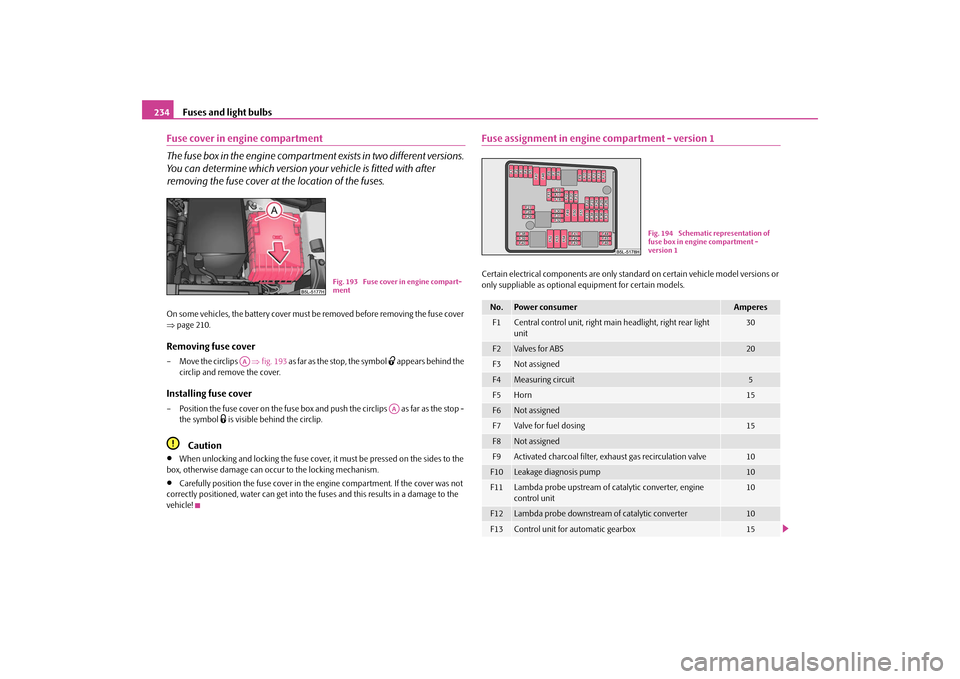
Fuses and light bulbs
234
Fuse cover in engine compartment The fuse box in the engine compartment exists in two different versions. You can determine which version your vehicle is fitted with after removing the fuse cover at
the location of the fuses.
On some vehicles, the battery cover must be removed before removing the fuse cover ⇒ page 210.Removing fuse cover– Move the circlips
⇒fig. 193
as far as the stop, the symbol
appears behind the
circlip and remove the cover.
Installing fuse cover– Position the fuse cover on the fuse box and
push the circlips as far as the stop -
the symbol
is visible behind the circlip.
Caution
•
When unlocking and locking the fuse cover, it must be pressed on the sides to the
box, otherwise damage can occur to the locking mechanism.•
Carefully position the fuse
cover in the engine compartment. If the cover was not
correctly positioned, water can get into the
fuses and this results in a damage to the
vehicle!
Fuse assignment in engine compartment - version 1Certain electrical components are only stan
dard on certain vehicle model versions or
only suppliable as optional
equipment for certain models.
Fig. 193 Fuse cover in engine compart- ment
AA
AA
No.
Power consumer
Amperes
F1
Central control unit, right main headlight, right rear light unit
30
F2
Valves for ABS
20
F3
Not assigned
F4
Measuring circuit
5
F5
Horn
15
F6
Not assigned
F7
Valve for fuel dosing
15
F8
Not assigned
F9
Activated charcoal filter, ex
haust gas recirculation valve
10
F10
Leakage diagnosis pump
10
F11
Lambda probe upstream of catalytic converter, engine control unit
10
F12
Lambda probe downstream
of catalytic converter
10
F13
Control unit for automatic gearbox
15
Fig. 194 Schematic representation of fuse box in engine compartment - version 1
sgg.6.book Page 234 Thursday, September 24, 2009 2:32 PM
Page 237 of 271
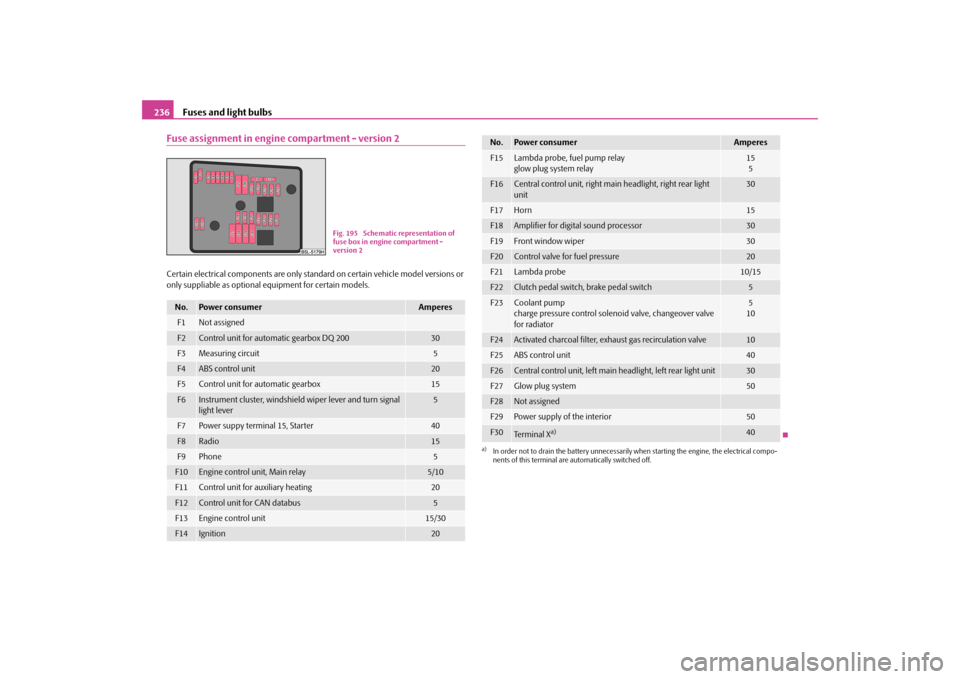
Fuses and light bulbs
236
Fuse assignment in engine compartment - version 2Certain electrical components are only standard on certain vehicle model versions or only suppliable as optional
equipment for certain models.
No.
Power consumer
Amperes
F1
Not assigned
F2
Control unit for automatic gearbox DQ 200
30
F3
Measuring circuit
5
F4
ABS control unit
20
F5
Control unit for automatic gearbox
15
F6
Instrument cluster, windshield
wiper lever and turn signal
light lever
5
F7
Power suppy terminal 15, Starter
40
F8
Radio
15
F9
Phone
5
F10
Engine control unit, Main relay
5/10
F11
Control unit for auxiliary heating
20
F12
Control unit for CAN databus
5
F13
Engine control unit
15/30
F14
Ignition
20
Fig. 195 Schematic representation of fuse box in engine compartment - version 2
F15
Lambda probe, fuel pump relay glow plug system relay
155
F16
Central control unit, right main headlight, right rear light unit
30
F17
Horn
15
F18
Amplifier for digital sound processor
30
F19
Front window wiper
30
F20
Control valve for fuel pressure
20
F21
Lambda probe
10/15
F22
Clutch pedal switch, brake pedal switch
5
F23
Coolant pump charge pressure control soleno
id valve, changeover valve
for radiator
5 10
F24
Activated charcoal filter, ex
haust gas recirculation valve
10
F25
ABS control unit
40
F26
Central control unit, left main
headlight, left rear light unit
30
F27
Glow plug system
50
F28
Not assigned
F29
Power supply of the interior
50
F30
Te r m i n a l X
a)
40
a)In order not to drain the battery unnecessarily wh
en starting the engine, the electrical compo-
nents of this terminal are automatically switched off.No.
Power consumer
Amperes
sgg.6.book Page 236 Thursday, September 24, 2009 2:32 PM
Page 244 of 271
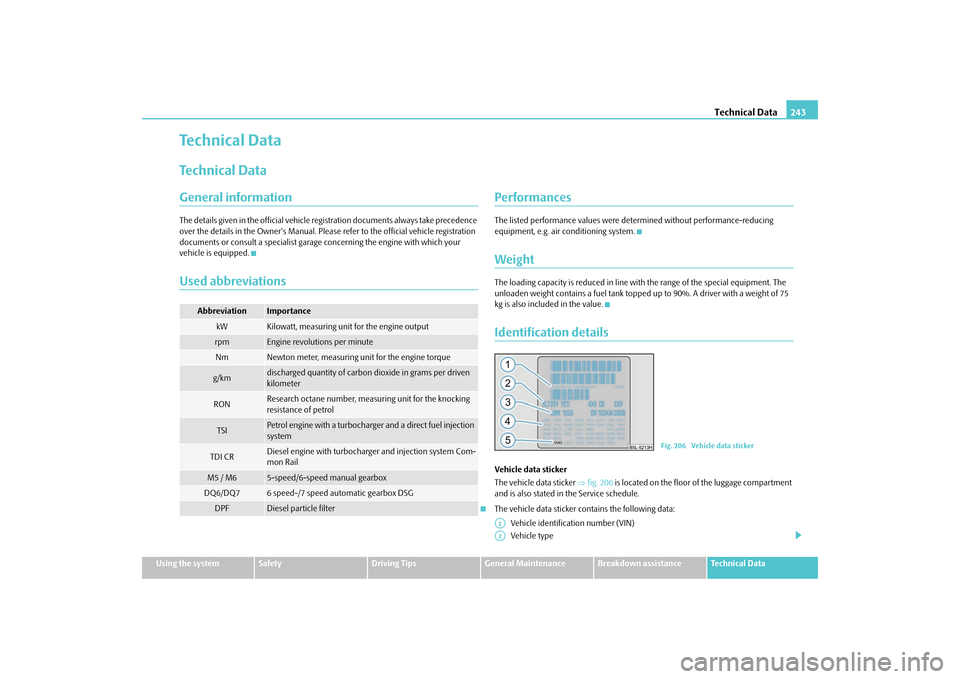
Technical Data
243
Using the system
Safety
Driving Tips
General Maintenance
Breakdown assistance
Technical Data
Te c h n i c a l D a t aTechnical DataGeneral informationThe details given in the official vehicle regi
stration documents always take precedence
over the details in the Owner's Manual. Please refer to the official vehicle registration documents or consult a specialist garage
concerning the engine with which your
vehicle is equipped.Used abbreviations
PerformancesThe listed performance values were de
termined without performance-reducing
equipment, e.g. air
conditioning system.
WeightThe loading capacity is reduced in line with the range of the special equipment. The unloaden weight contains a fuel tank topped
up to 90%. A driver with a weight of 75
kg is also includ
ed in the value.
Identification detailsVehicle data sticker The vehicle data sticker
⇒fig. 206
is located on the floor of the luggage compartment
and is also stated in the Service schedule. The vehicle data sticker co
ntains the following data:
Vehicle identification number (VIN) Vehicle type
Abbreviation
Importance
kW
Kilowatt, measuring unit for the engine output
rpm
Engine revolutions per minute
Nm
Newton meter, measuring
unit for the engine torque
g/km
discharged quantity of carbon dioxide in grams per driven kilometer
RON
Research octane number, meas
uring unit for the knocking
resistance of petrol
TSI
Petrol engine with a turbocharger and a direct fuel injection system
TDI CR
Diesel engine with turbocharger and injection system Com- mon Rail
M5 / M6
5-speed/6-speed manual gearbox
DQ6/DQ7
6 speed-/7 speed automatic gearbox DSG
DPF
Diesel particle filter
Fig. 206 Vehicle data sticker
A1A2
sgg.6.book Page 243 Thursday, September 24, 2009 2:32 PM
Page 249 of 271
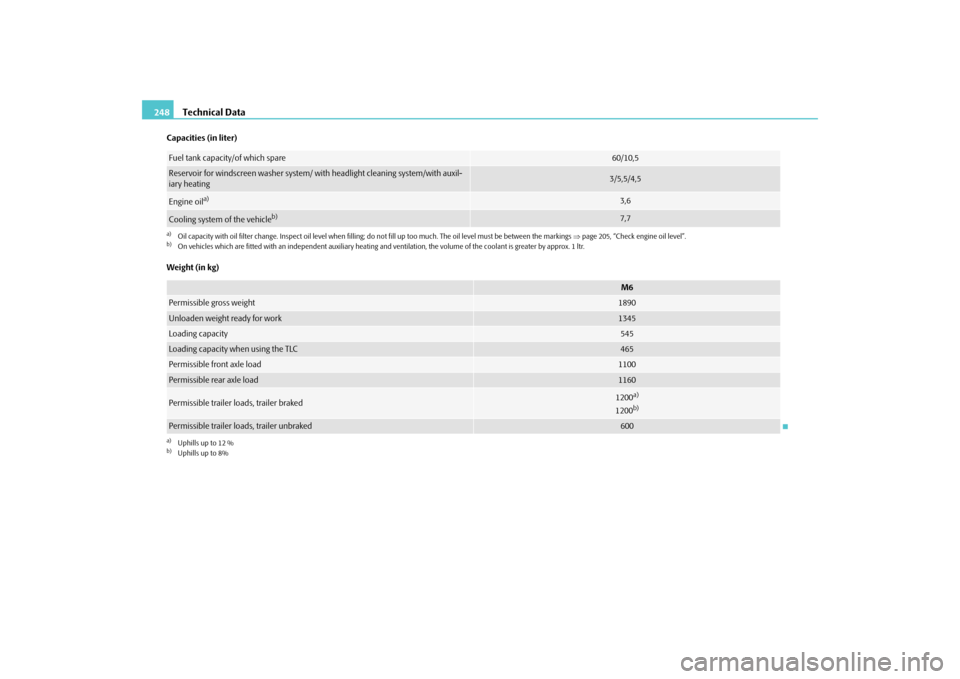
Technical Data
248
Capacities (in liter) Weight (in kg)Fuel tank capaci
ty/of which spare
60/10,5
Reservoir for windscreen washer system/ wi
th headlight cleaning
system/with auxil-
iary heating
3/5,5/4,5
Engine oil
a)
a)Oil capacity with oil filter change. Inspec
t oil level when filling; do not fill up too much. The oil level must be between the
markings
⇒page 205, “Check engine oil level”.
3,6
Cooling system of the vehicle
b)
b)On vehicles which are fitted with an independent auxiliary heatin
g and ventilation, the volume of the coolant is greater by app
rox. 1 ltr.
7,7M6
Permissible gross weight
1890
Unloaden weight ready for work
1345
Loading capacity
545
Loading capacity when using the TLC
465
Permissible front axle load
1100
Permissible rear axle load
1160
Permissible trailer loads, trailer braked
1200
a)
1200
b)
a)Uphills up to 12 %b)Uphills up to 8%Permissible trailer loads, trailer unbraked
600
sgg.6.book Page 248 Thursday, September 24, 2009 2:32 PM